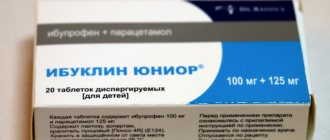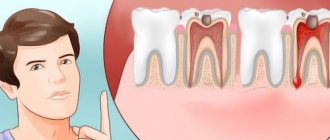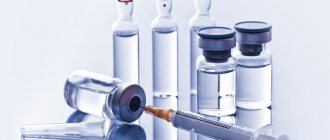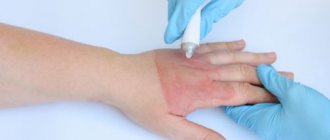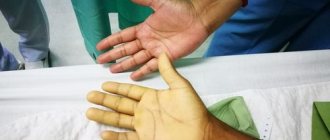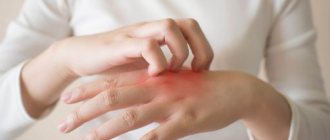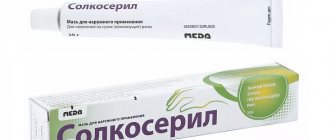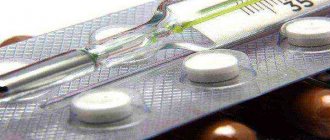To help the body cope with the inflammatory process, anti-inflammatory drugs are prescribed. They are also called non-steroidal or non-hormonal. The short name is NSAID. The first known anti-inflammatory drug is Aspirin or acetylsalicylic acid.
Such drugs have many side effects, so their uncontrolled use is not permissible. Classic NSAIDs have side effects on the digestive organs, cardiovascular and nervous systems.
New generation non-steroidal anti-inflammatory drugs simultaneously have anti-inflammatory, analgesic and antipyretic effects.
How and why does the inflammatory process occur in the human body?
Inflammation is the body's defense method, allowing it to eliminate germs, harmful substances and dead cells. The inflammatory process can begin due to many reasons, including infections caused by bacteria and viruses, the action of chemicals, and also as a result of foreign bodies entering the body.
Inflammation can be acute or chronic. In the chronic form it occurs more slowly and for a long time. The main symptoms of the inflammatory process are redness, swelling, pain, fever and loss of certain functions.
What is it and how does it work
Regardless of the group and form of release, NSAIDs always have three pharmacological effects: anti-inflammatory, analgesic and antipyretic. To understand the mechanism of action, you need to know something about inflammation and pain.
Inflammation is the sequential release of chemicals. One of them is cyclooxygenase type 1 and 2 (COX-1 and 2), which plays a key role in the synthesis of prostaglandins, active substances that dilate local blood vessels, cause swelling, pain and increase temperature, that is, develop typical signs of inflammation.
The physiological effect of NSAIDs is that they block the production of cyclooxygenase, thereby preventing prostaglandins from being synthesized and causing inflammatory reactions. Or, if it is already there, NSAIDs suppress it.
According to their effects, they come in three types:
- Non-selective - predominantly block COX-1, to a lesser extent COX-2: aspirin, indomethacin, diclofenac, paracetamol, ibuprofen, naproxen;
- Selective - block mainly COX-2, but also partially COX-1: nimesulide, meloxicam, etodolac;
- Highly selective - block only COX-2: celecoxib, rofecoxib, valdecoxib.
This is a fundamental and important division in clinical practice. The fact is, prostaglandins are not only inflammatory substances, but also a protective factor for the stomach: there they reduce acid secretion and increase mucus production.
It turns out that when using non-selective NSAIDs, the production of not only “inflammatory” prostaglandins is suppressed, but also physiological ones in the stomach, which often leads to side effects: abdominal pain, nausea, diarrhea, bloating, even ulcers and gastric bleeding. That is why doctors, when prescribing non-selective drugs, sometimes add proton pump blockers (for example, omeprazole), which reduce the secretion of gastric acid and protect the stomach from the harmful effects of NSAIDs.
“A common side effect of anti-inflammatory drugs is erosive and ulcerative lesions of the gastrointestinal tract. Fortunately, the doctor has enough tools to minimize damage to the stomach,” GMS Clinic neurologist Sergei Makarov shares his experience. When taking a course of NSAIDs to treat, for example, exacerbation of back pain, patients at risk of developing side effects are prescribed proton pump inhibitors - drugs that reduce the production of hydrochloric acid in the stomach. To prevent stomach damage, an additional dose of proton pump inhibitors is required in the morning 30 minutes before breakfast. The course of treatment is usually determined by the attending physician.”
Any NSAID can be potentially toxic, especially in chronic diseases of the liver, kidneys and cardiovascular system. Also, the likelihood of complications increases with uncontrolled use - without a doctor’s prescription and supervision, and if the dose and duration of use specified in the instructions are exceeded. To ensure that taking anti-inflammatory drugs does not harm the body, it must be agreed with the attending physician who knows about the patient’s chronic pathologies.
Indications for the use of anti-inflammatory drugs
- Rheumatic diseases (rheumatic fever, ankylosing spondylitis, rheumatoid, gouty and psoriatic arthritis, Reiter's syndrome).
- Non-rheumatic diseases of the musculoskeletal system (myositis, tendovaginitis, household and sports injuries, osteoarthritis).
- Neurological diseases (sciatica, neuralgia, lumbago, sciatica).
- Renal and hepatic colic.
- Pain syndrome of various origins, including abdominal pain, headache and toothache, pain after surgery.
- Fever.
- Dysmenorrhea.
- For the prevention of arterial thrombosis.
What are there
They are produced in tablets, capsules, suppositories, suspensions, injection solutions, ointments and gels. Each of the forms is intended for something specific, for example, ointment - for the treatment of sprains, injection - when a “shock” dose is needed, tablets and capsules, for example, for fever or moderate pain, and suppositories, or “suppositories”, for inflammatory diseases of the rectum and female genital organs, or when due to nausea and vomiting it is not possible to take a pill.
You can read the continuation of the article by following the link to FORMA - SBER PHARMACY blog.
What are the contraindications?
- Ulcerative lesions of the gastrointestinal tract in the acute stage.
- Severe renal and liver dysfunction.
- Individual intolerance to the main active ingredient and auxiliary ingredients.
- Pregnancy and lactation.
- Individual intolerance to drug components.
- Children under 2 years old.
Anti-inflammatory drugs should be prescribed with caution to people suffering from bronchial asthma, as well as people who have already experienced adverse reactions when taking medications. For patients with arterial hypertension or heart failure, NSAIDs are chosen that have the least effect on renal blood flow. Elderly people are prescribed the minimum effective doses of NSAIDs in short courses.
pharmachologic effect
Anti-inflammatory drugs inhibit inflammation by blocking enzymes that are involved in the formation of special inflammatory factors - prostaglandins: glucocorticosteroids inhibit the enzyme phospholipase A2, non-steroidal anti-inflammatory drugs - the enzyme cyclooxygenase-2.
Glucocorticoids additionally have an antiallergic, immunosuppressive (immunosuppressive) effect, increase blood pressure (anti-shock effect), and activate the liver’s ability to neutralize toxins (antitoxic effect).
In addition to their anti-inflammatory effect, non-steroidal anti-inflammatory drugs also have the ability to reduce pain (analgesic effect) and reduce elevated body temperature (antipyretic effect).
Antirheumatic drugs have an anti-inflammatory and immunosuppressive effect due to inhibition of the formation of specific signaling molecules responsible for the implementation of inflammation - cytokines: tumor necrosis factor-α, interleukin-1 receptors.
Types of anti-inflammatory drugs
Modern medications cope with inflammation of any nature and have a long-lasting effect. They are often prescribed when pain needs to be relieved.
- Hormonal drugs . They have a much stronger effect than non-hormonal ones. The basis of such drugs is cortisol. They act on the principle of local immune suppression. And at the same time, such drugs have many more contraindications and side effects.
They are prescribed for severe skin allergies, rheumatoid arthritis, vascular inflammation, hepatitis, and inflammation of skeletal muscles.
- Combined means . These medications include combinations of several components. Thanks to this, the therapeutic effect is greatly increased.
- Nonsteroidal drugs . These drugs act selectively on types of cyclooxygenase, inhibiting their activity. COX is responsible for the creation of biologically active components. Due to the suppression of COX activity, the amount of these substances in tissues decreases and inflammation disappears.
Forms of the disease
Treatment of inflammation of the appendages in women should begin by determining the stage of the disease. There are three forms of development of adnexitis:
- chronic;
- acute;
- subacute
Any of the stages is accompanied by certain symptoms and is dangerous for the body. The lack of proper treatment will worsen the situation, and the consequences of the disease will be more severe.
Acute form of the disease
This stage of disease development occurs immediately after the end of the latent period of infection. The symptoms of this form clearly indicate the presence of problems in the gynecological area. The initial stage of inflammation of the appendages is accompanied by the following symptoms:
- increase in body temperature;
- the presence of purulent vaginal discharge with an unpleasant odor;
- chills;
- the presence of discomfort and pain during sexual intercourse;
- increased sweating;
- decreased sexual desire;
- severe headaches;
- difficulty urinating;
- menstrual irregularities.
Most signs confirm the presence of a strong inflammatory process in the body. The development of adnexitis is indicated by problems with the regularity of the menstrual cycle and pain in the genital area.
Subacute form of the disease
At this stage, the signs of inflammation of the appendages are identical to the above symptoms. This is due to the fact that the subacute form is a periodic occurrence of exacerbations. The intensity of all symptoms is reduced. A complete absence of signs of the disease cannot be ruled out. In this case, diagnosing and monitoring the progress of treatment becomes very difficult. The presence of the disease at this stage is indicated by:
- irregular menstrual cycle, often accompanied by pain;
- slight decrease in sexual desire;
- pain that occurs in the lower abdomen, which is paroxysmal in nature.
The subacute stage gradually turns into the chronic stage. Correct therapy will alleviate the condition and prevent serious complications from developing.
Chronic form of the disease
Having passed to this stage, most diseases of the genital area lose their characteristic signs. Inflammation of the appendages is accompanied by symptoms that are characteristic of the subacute form, although they are less pronounced. The symptoms are as follows:
- the presence of unbearable pain during sexual intercourse;
- short period of menstruation, which does not exceed two days;
- lack of sexual desire;
- the presence of intestinal disorders;
- inability to get pregnant;
- presence of bloody vaginal discharge.
The chronic stage often transitions back to the subacute stage. This phenomenon occurs due to a strong decrease in the protective function of the immune system. This occurs when the body is significantly hypothermic or during prolonged exposure to a stressful situation. It is worth seeking gynecological help if there are several signs of inflammation of the appendages; self-treatment often leads to complications and infertility.
How to take anti-inflammatory medications correctly?
First you need to carefully read the instructions. The drugs must be prescribed by the attending physician and the optimal dose and course of treatment determined. To protect the stomach, tablets should be taken with a sufficient amount of clean water.
Under no circumstances should you mix medications with alcohol. This will further affect the functioning of the stomach.
You can buy all drugs for the treatment of inflammatory processes in the network of state pharmacies “Provincial Pharmacies”. We provide medicines with a state quality guarantee. There is a pick-up system and home delivery when ordering drugs online.
Causes of the disease
Inflammation often indicates the presence and active development of infections in the body.
In most cases, the causative agents of adnexitis are:
- gonorrhea;
- Trichomonas;
- chlamydia.
Pathogenic microorganisms actively develop and multiply if the immune system is weakened. Having penetrated inside, the infection will remain latent until the protection fails.
The following factors can provoke a decrease in the function of the immune system:
- psychological or physical fatigue;
- violation of the daily routine;
- poor nutrition;
- frequent exposure to stressful situations;
- recent colds;
- hypothermia.
Inflammation of the appendages in women can be provoked by overly active sexual relations and unprotected sexual intercourse. They contribute to the appearance of infection in the body.
A negative factor that provokes the development of the inflammatory process is the rapid resumption of sexual activity in a woman who has recently given birth to a baby. During this period, the immune system is still weakened and is not able to resist pathogenic microflora.
What you need to remember when taking an NSAID drug
Medicines in this category have a fairly quick pain-relieving effect, so many patients do not deny themselves an “extra pill.” In fact, this approach is very dangerous, since an overdose is fraught with serious complications. Therefore, doctors strongly recommend:
- take such medications only as prescribed by a doctor and in the dosage indicated by him;
- do not combine the use of several drugs from this group at once;
- take medications only with water, since tea, coffee, juice or milk distort the effect of the drug;
- do not self-medicate.
Simultaneous use of non-steroidal drugs and alcohol is incompatible and life-threatening
Treatment with anti-inflammatory drugs alone is ineffective. This is only part of complex therapy for age-related or post-traumatic arthrosis. To restore joint mobility, it is necessary to undergo a course of intra-articular injections, for example, Noltrex, to eliminate the deficiency of synovial fluid in the joint capsule and stop painful friction of cartilage. In some cases, long-term use of chondroprotectors, physiotherapy and other therapeutic methods are indicated. Only an integrated approach will bring results.
How to treat inflammation of the appendages: methods of folk and traditional medicine
Therapy is aimed at destroying the infection, restoring tissues affected by the disease and relieving pain. Inflammation of the appendages in women is treated not only with antibiotics, but also with drugs that support the immune system.
Drug therapy
Medicines are selected taking into account the individual characteristics of the patient and the presence of allergies. The following antibiotics are usually prescribed:
- Gentamicin;
- Claforan;
- Cephobid;
- Cefazolin;
- Ciprofloxacin;
- Doxycycline;
- Ofloxacin;
- Lincomycin.
For effective treatment, specialists use the complex use of the above remedies.
In addition to antibiotics, medications that have an anti-inflammatory effect are prescribed:
- Diflucan;
- Ibuprofen;
- Orphtofen.
To treat inflammation of the appendages in women, antihistamines are used, which reduce the risk of allergic reactions. Popular products in this category are Zodak, Zyrtec, Erius.
Surgery may be required at the initial stage of the disease. They resort to surgery in the following cases:
- adhesions in the pelvic organs;
- formation of a purulent cavity;
- loss of patency of the fallopian tube.
Therapy in the above cases is carried out in a hospital setting. It is impossible to cope with the disease at home.
Treatment of inflammation of the appendages in women with “grandmother’s recipes”
Traditional medicine helps stop the development of inflammation and the spread of infection. But they are not able to cure the patient, since only antibiotics can kill pathogenic microorganisms.
The following recipes are used in the treatment of adnexitis:
- For treatment, a decoction of a mixture of roots is used - Chernobyl, elecampane, peony, buckthorn and burnet. Two tablespoons filled with half a liter of hot water is enough. The broth is boiled over low heat for about half an hour, cooled and filtered for the same amount of time. Take half a glass 3-4 times a day. To improve the taste of the healing drink, honey is added. This bee product helps strengthen the immune system and gives the body strength to fight infection.
- They take a medicinal plant such as boron uterus and grind its dried leaves. A tablespoon of medicinal herb is poured with boiling water, one glass is enough. Leave to infuse, filter after two hours. The resulting decoction is taken in a third of a glass. It is recommended to consume 30 minutes before meals three times a day. The duration of the course is one month. After completing therapy with a decoction of boron uterus, it is recommended to drink an infusion of Yakut field grass for two months. To prepare the drink, add a tablespoon of dried herb to a glass of boiling water. Infuse and filter after four hours. A single serving is one teaspoon. The decoction is taken 3-4 times a day.
- Dried, pre-crushed flowers of coltsfoot, centaury and sweet clover are taken in equal proportions. Add a glass of boiling water to the resulting mixture and leave to infuse. After an hour, filter the broth using gauze. The cooled medicine is taken half a glass twice a day. Treatment with this method involves abstaining from sexual activity for the full course.
Diagnosis
Before making preliminary conclusions and making a diagnosis, the gynecologist will collect an anamnesis. Diagnosis of inflammation of the appendages is valuable, but the doctor will prescribe treatment only after clarifying the degree of damage to the body and identifying the causative agent of the disease. Adnexitis is one of the diseases of the genital area that requires instrumental intervention for diagnosis.
First, the doctor conducts a clinical examination of the patient in a gynecological chair. The exact picture of the disease does not always become clear, so the gynecologist prescribes ultrasound diagnostics. The procedure will reveal changes in the genital organs, as well as confirm the presence of inflammation in the body. It is extremely rare for a specialist to prescribe an MRI. Typically, the diagnostic method is used when cancer is suspected.
A mandatory step in making a diagnosis is taking tests. They help determine the exact type of causative agent of the disease. The doctor prescribes:
- bioseeding;
- PCR;
- examination of a smear under a microscope.
The biomaterial is the patient’s vaginal secretions or blood. Rarely is an oral sample used for testing. A general blood test will confirm the presence of inflammation in the body, but will not determine the strain of pathogenic microorganisms.
